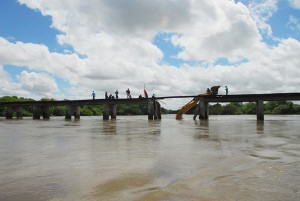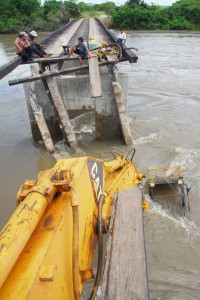The recently constructed $16M Rupu-nuni River bridge that caved in under an excavator is not expected to be repaired until next month or October, Chairman of Region Nine (Upper Takutu/Upper Esse-quibo), Clarindo Lucas said yesterday.

He told Stabroek News that the bridge is not expected to undergo repairs until September or October when the high water recedes. A portion of the structure collapsed under the weight of an excavator that was heading to a mine in the South Rupununi several weeks ago. The bridge, located in the vicinity of the Amerindian village of Katoonarib is one of only two that has been built over the Rupununi River. The other is located in the village of Karaudarnau in the Deep South Rupununi.
Rain has been deluging the South Rupununi in the past few weeks and Lucas said that with the heavy flooding no work can be done as the region does not have the technical capacity. He said that all activity has stopped on such works in the sprawling region due to the rains. The contractor, who built the bridge, is a Lethem contractor. The bridge has since been officially closed.
Meantime, recounting the incident, a source related that the bridge caved in at about mid-day on May 27 when the excavator was crossing. “The driver luckily was washed out of the cabin by the rushing water and managed to swim to shore”. Several days later a bulldozer and another excavator managed to pull the fallen excavator back out of the river and it was repaired, following which it was taken to Aishalton, which is the largest village in the Deep South Rupununi. The source said that apart from the middle of the bridge being broken, “the beams from the western bank to the middle are now all cracked and probably very unsafe for any other traffic.” Additionally, when the river is very high, the banks on both sides of the river at the bridge are flooded for quite a distance.
The excavator belonged to a Brazilian gold miner, who has obtained some mining blocks in the Marudi area, according to the resident. Traffic is currently moving through Dadanawa Ranch using the pontoon there to cross the river. The broken bridge is located ten miles upriver from Dadanawa, which was where vehicles previously crossed the Rupununi River before the structure was built.
The bridge is the major structure over the said river that links the southern part of the savannah to the rest of the region. The only other bridge over the waterway is at Karaudarnau and that one was commissioned in 2004 after being built at a cost of $3.5M. It is a steel and wooden structure. However, because the road leading to this bridge is not in the very best of condition, though it has improved in recent times, the bridge is not regularly utilized.
The heavy rains and the current state of the road have limited traffic to the area in recent times, this newspaper understands.
Meantime, the source pointed out that the site of the bridge makes the road to the South Rupununi five miles longer and leaves out access to the villages of Rupunau, Shea, Sand Creek and Maruranau. The source declared that the Rupununi River Bridge bypasses a similar structure built at Araquoi Creek last year to facilitate travel to the South savannah “making Araquoi Bridge redundant”.
The region and the government have not released any information on the collapsed Rupununi bridge.
Another resident noted that millions of dollars had been spent on both bridges.

Meanwhile, the unusually heavy rains in the Deep South Rupununi had flooded farmlands and caused the adobe walls on some homes in Aishalton to collapse. Aishalton resident, Tony James in an email to this reporter said that several walls of homes in the village collapsed. “Cassava farms have been very much affected”, he stated adding that fish, a major source of food there, has been limited due to the high water in the rivers.
This newspaper understands too that in several other villages in the district, the walls of the homes of some residents have also collapsed. Villagers also have had their farms flooded and according to reports, cassava, the main staple of the Amerindian’s diet, is limited. Toshaos of the six villages in the Deep South Rupununi were holding a meeting in Aishalton yesterday.





